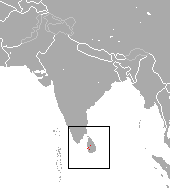
The Asian house shrew is a shrew species native to South and Southeast Asia that has been listed as Least Concern on the IUCN Red List since 2008 because of its large population and wide distribution. It has been introduced in several West Asian and East African countries. It is considered an invasive species and implicated in the demise of several island lizard species.

The black shrew is a white-toothed shrew only known from Mount Kinabalu in the Malaysian state of Sabah on the island of Borneo.

The Flores shrew is a white-toothed shrew found only on Flores Island, Indonesia. It is listed as an endangered species due to habitat loss and a restricted range.

Suncus is a genus of shrews in the family Soricidae.

The great elaenia is a species of bird in the family Tyrannidae, the tyrant flycatchers. It is endemic and restricted mostly to the higher altitude plateau-Tepuis of Venezuela and far northern Brazil, and may also occur in Guyana.

The Sri Lankan shrew, also called Gordon's pygmy shrew, is a species of mammal in the family Soricidae. It is endemic to Sri Lanka. It is threatened by habitat loss. It is known as හික් මීයා in Sinhala. It was named after the wife of A. C. Tutein-Nolthenius, Marjory née Fellowes-Gordon, who collected specimens of the shrew and provided them to Phillips.

The Bornean pygmy shrew is a species of shrew in the family Soricidae. It was named for zoologist Charles Hose.

The least dwarf shrew is a species of mammal in the family Soricidae. It is found in Cameroon, Central African Republic, Democratic Republic of the Congo, Kenya, Nigeria, South Africa, Eswatini, Tanzania, and Uganda. Its natural habitats are tropical or subtropical moist lowland and montane forests, dry grassland, and arable land.

The greater dwarf shrew is a species of mammal in the family Soricidae. It is found in Angola, Botswana, Democratic Republic of the Congo, Kenya, Malawi, Namibia, Tanzania, Zambia, and Zimbabwe. Its natural habitats are subtropical or tropical dry forests and dry savanna. It is present in several protected areas, including the Kruger National Park. The main threat to greater dwarf shrews is the loss or degradation of moist, productive areas such as wetlands and rank grasslands within suitable habitat.

The Malayan pygmy shrew is a species of mammal in the family Soricidae. It can be found in Malaysia and Thailand. Its natural habitat is subtropical or tropical dry forests.

The Asian highland shrew is a species of mammal in the family Soricidae. It is found in India and Sri Lanka. Its habitat is subtropical or tropical dry forests.

Remy's pygmy shrew is a species of mammal in the family Soricidae. It is found in Cameroon, the Central African Republic, the Republic of the Congo, and Gabon. Its natural habitat is subtropical or tropical moist lowland forests.

Anderson's shrew is a medium-sized species of shrew. It is light gray in color with yellow fur around the throat and pectoral region, comparatively large ears and a tail that measures about 50 – 70% of body length. This shrew species is widespread, found in India, Nepal, Pakistan and possibly Bangladesh, in gardens and grassy embankments near watercourses, under piles of brushwood in forest plantations (Punjab) as well as the bases of stone walls in Kathiawar, and also in desert and arid country. As far as is known, the habits of the Anderson's shrew are largely nocturnal and solitary. Breeding may extend throughout the year.

The lesser dwarf shrew is a species of mammal in the family Soricidae. It is found in Botswana, Democratic Republic of the Congo, Lesotho, Malawi, Mozambique, South Africa, Tanzania, Zambia, and Zimbabwe.

The jungle shrew is a species of mammal in the family Soricidae endemic to Sri Lanka. Its natural habitat is subtropical or tropical dry forests. It is threatened by habitat loss.

The climbing shrew is a species of mammal in the family Soricidae, which is found in subtropical Africa. It is found in Angola, Benin, Burundi, Cameroon, Central African Republic, Republic of the Congo, Democratic Republic of the Congo, Ivory Coast, Ethiopia, Ghana, Guinea, Kenya, Liberia, Malawi, Mozambique, Nigeria, Rwanda, Sierra Leone, South Sudan, Tanzania, Togo, Uganda, Zambia, and Zimbabwe. Its natural habitats are subtropical or tropical moist lowland and montane forests, and moist savanna.

The Negev shrew, also known as the Ramon's shrew is a species of mammal in the family Soricidae. So far, it is only known from Israel. It is found in three regions: Mizpe Ramon and Sede Boqer in the Negev Desert, and Sartaber at the northern edge of the Judean Desert. It is likely that the species occurs more widely in the region than currently known. The three locations in which the species occur are rocky desert areas at altitudes between 200 and 950 metres above sea level. The Negev shrew is light gray with a slightly lighter underpart. It is also relatively small.

The Taita shrew is an extant species of white-toothed shrew from two localities in the Taita Hills mountain range in the Taita-Taveta District of southwestern Kenya. Given the continuing decline in the quality of this habitat, and the limitations in its range, the IUCN recognises the shrew as an endangered species.
The Hutu-Tutsi dwarf shrew is a species of mammal in the family Soricidae. It is known from a small portion of the mountains of tropical Africa.


















